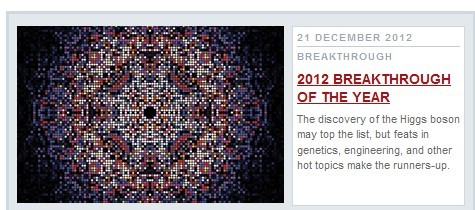Daya Bay Neutrino Experiment Results Listed Breakthrough of the Year 2012
Updatetime:2012-12-28From:
【Enlarge】【Reduce】
On December 20, 2012, Science Magazine announced the top ten Breakthroughs of the Year 2012 to the public. The discovery of a new kind of neutrino transformation, the  scientific achievement of the Daya Bay Reactor Neutrino Experiment was selected as one of the nine runners-up of this year’s breakthrough, and the winner went to the discovery of the Higgs Boson.
scientific achievement of the Daya Bay Reactor Neutrino Experiment was selected as one of the nine runners-up of this year’s breakthrough, and the winner went to the discovery of the Higgs Boson.
 scientific achievement of the Daya Bay Reactor Neutrino Experiment was selected as one of the nine runners-up of this year’s breakthrough, and the winner went to the discovery of the Higgs Boson.
scientific achievement of the Daya Bay Reactor Neutrino Experiment was selected as one of the nine runners-up of this year’s breakthrough, and the winner went to the discovery of the Higgs Boson.It is written in the magazine that scientists in China have measured the third and final “mixing angle” that can be used to describe neutrinos. Sometimes it's not the result itself so much as the promise it holds that matters most. This year, physicists measured the last parameter describing how elusive particles called neutrinos morph into one another as they zip along at near–light speed. And the result suggests that in the coming decades neutrino physics will be every bit as rich as physicists had hoped—and may even help explain how the universe evolved to contain so much matter and so little antimatter.
The Daya Bay Reactor Neutrino Experiment is a China-based multinational particle physics project studying neutrinos. The multinational collaboration includes researchers from China, the United States, Taiwan, and the Czech Republic. The US side of the project is funded by the US Department of Energy's Office of High Energy Physics. It is situated at Daya Bay, approximately 52 kilometers north of Hong Kong and 45 kilometers east of Shenzhen.
The experiment studies neutrino oscillations and is designed to measure the mixing angle θ13 using antineutrinos produced by the reactors of the Daya Bay Nuclear Power Plant and the Ling Ao Nuclear Power Plant. On 8 March 2012, the Daya Bay collaboration announced discovery of a new kind of neutrino transformation and an accurate measurement of theta13. This significant achievement received strong responses from the international field of physics and was commented as a milestone in the research of neutrino physics.
For the original news in Science, please click:
Appendix




